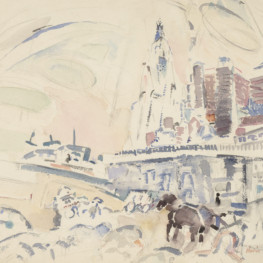John Marin
1870 - 1953
A major figure in early twentieth-century modernism, John Marin captured the colliding energies of the American urban scene and the vibrant contrasts of natural elements in the coastal landscape of Maine and other countryside locales. As one of the premier watercolorists of his era, Marin developed a light, spontaneous style ideally suited to conveying the freshness and flux of city and country experience — his watercolors are often considered to match in strength those created by Winslow Homer in previous century. At the same time, Marin’s sensitivity to mass, form, color, and line and their dynamic interchanges provided a precedent for the Abstract Expressionist movement of the late 1950s.
Marin was born in Rutherford, New Jersey, to a family of European descent. After studying mechanical drawing and mathematics for half a year at the Stevens Institute of Technology in New York, Marin worked as a draftsman for several architects. It was not until he was almost thirty years old that he began to study art. He enrolled at the Pennsylvania Academy of the Fine Arts in Philadelphia from 1899 to 1901, and at the Art Students League in New York from 1901 to 1903, where his teachers were William Merritt Chase and Frank Vincent Dumond. While Marin was attending the League, the radical ideas of Arthur Wesley Dow were being disseminated and had an impact on the direction Marin would soon take in his art.
Marin left for Europe in 1905. The next five years, which he spent abroad, were of tremendous importance to his career. He became a significant figure in the expatriate community in Paris, frequenting the Dôme, a café that served as a meeting place for artists and writers. While in Europe, Marin visited the Louvre and the Rijksmuseum in Amsterdam and, despite his claims that he had been indifferent to the Paris art world, he undoubtedly became aware of the art of Paul Cézanne and Henri Matisse. The works Marin created in Europe most strongly reflect the influence of James McNeill Whistler, especially the pastels he rendered in Venice.
In the summer of 1909, Marin met Alfred Stieglitz in Paris. In February of the next year, Marin’s work was shown along with that of Alfred Maurer at Stieglitz’s gallery, 291. After returning to America in the following year, Marin became one of the most consistent members of Stieglitz’s inner circle, showing at all three of his galleries — 291, The Intimate Gallery, and An American Place. After 1910, Marin developed the routine that he would follow for the rest of his life, creating paintings, drawings, and prints in New York City and surrounding areas during the winter, and in the summer, traveling to the country, where he focused on the particular characteristics of the regions that he visited. He worked mainly in watercolor until 1928, when he began also to use oil.
Marin never became purely abstract. He formulated a unique style melding influences of the art of the French Fauves, Cézanne, Matisse, and the French Cubists with a personal style of luminescent colors, agile brushwork, and a simultaneously delicate and strong handling. In city views, he used broken lines, a light touch, fluid color, and rhythmic compositions to convey what he described as the “great forces at work.” He expressed the warring of the great and the small through relationships between masses. As he said, he sought to express the “pull forces” of the modern urban scene. Often portraying the new tall buildings of New York seen in the midst of radiating, fragmented forms of city and sky, he conveyed the hectic forces and explosive growth and promise of America. His images of the Woolworth building, in particular, suggest the incredible defiance of gravity achieved by the modern skyscraper. Using plunging sight lines and Cubist multi-perspectives, in his views of buildings, bridges, and other urban architectural forms, Marin created vivid pictorial equivalents of the American city of the early twentieth century.
In 1914, Marin discovered the other subject that would dominate his art. As had Homer and many other American artists, he was compelled by the natural and untouched beauty of the Maine coast. The works he created over the course of many Maine summers express dynamic relations of ground, trees, water, clouds, and sky. Conveying the tension between the fluid forms of nature and the structures of art, he imposed order on his landscapes and reinforced his picture planes, while conveying the character of his sites. New Mexico was another locale that drew Marin’s attention. On a number of sojourns, he captured the stark grandeur of the countryside around Taos.
Marin received widespread acclaim during his life and posthumously. The Metropolitan Museum of Art and the Museum of Modern Art had solo shows of his art in 1924 and 1936. The Institute of Contemporary Art in Boston organized a traveling retrospective in 1947. The Los Angeles County Museum of Art held a major Marin show in 1970-1971, and in 1990, a large retrospective was held at the National Gallery of Art in Washington, D.C.
Marin’s work may be found in important private and public collections across the country including the National Gallery of Art, Washington, D.C., the Museum of Modern Art, New York; the Art Institute of Chicago; the Philadelphia Museum of Art; the Metropolitan Museum of Art, New York; Harvard University Art Museums, Cambridge, Massachusetts; the Hirshhorn Museum and Sculpture Garden, Smithsonian Institution, Washington, D.C.; Colby College Museum of Art, Waterville, Maine; Terra Museum of American Art, Chicago; the Munson-Williams-Proctor Institute, Utica, New York; the Phillips Collection, Washington, D.C.; the Wichita Art Museum, Kansas; the Detroit Institute of Art; the Albright-Knox Art Gallery, Buffalo, New York; the Whitney Museum of American Art, New York; and the Museum of Fine Arts, Boston.

